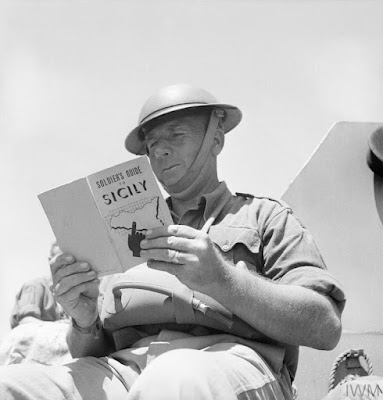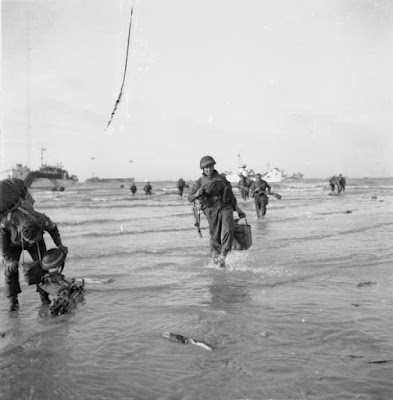World War II in Sicily ... Operation Husky
This year marks the 80th anniversary of the Allied Invasion of Sicily during World War II codenamed Operation Husky. There are many memorials and events taking place this year to commemorate those who fought in battle on the island.
The battle for Sicily is an extraordinary story ...
The Allied Invasion of Sicily was a major campaign of World War II in which the Allied forces invaded the island in July 1943 and took control of Sicily from the Axis powers (Fascist Italy and Nazi Germany). It began with a large amphibious (by sea) and airborne operation, followed by a six week land campaign. The 38 day battle for Sicily was one of the most dramatic of the entire Second World War and the island acted as a strategic stepping stone to Hitler's fortress Europe.
To divert some of the Axis forces to other areas, the Allies engaged in several deception operations, the most famous and successful of which was Operation Mincemeat.
Operation Husky began on the night of 9th/10th July 1943 and ended on the 17th August the following month.
Strategically Operation Husky achieved the goals set out for it by the Allied planners meaning that the Allies drove Axis air land and naval forces from Sicily and thus the Mediterranean sea lanes were opened to the Allied merchant ships for the first time since 1941. These events led to the Italian leader, Benito Mussolini, being toppled from power in Italy on 25th July and thereafter to the Allied Invasion of mainland Italy on the 3rd September.
The plan for Operation Husky called for the amphibious assault of Sicily by two Allied armies, one landing in the south eastern corner of the island and one on the central southern coastline. The amphibious assaults were to be supported by naval gunfire, as well as tactical bombing and air support by combined Allied air forces. The overall commander was American General Dwight Eisenhower as Commander-in-Chief of all the Allied forces in North Africa.
The Allied land forces were from the American, British and Canadian armies and were divided into two task forces. The Eastern Task Force was led by General Sir Bernard Montgomery and consisted of the British Eighth Army which included the 1st Canadian Infantry Division. The Western Task Force was commanded by Lieutenant General George S Patton and consisted of the American Seventh Army.
In addition to the amphibious landings airborne troops were flown in to support both the Eastern and Western Task Forces. Allied naval forces were also grouped into two task forces to transport and support the invading armies.
At the Casablanca Conference in January 1943, with the end of the North African war campaign in sight, the political leaders and the military Chiefs of Staff of the United States and Britain met to discuss future strategy. The British chiefs of Staff were in favour of an invasion of Sicily or Sardinia. At first the Americans opposed the plan but were persuaded to agree to a Sicilian invasion on the grounds of the great savings to Allied shipping that would result from the opening of the sea lanes. The plan would see the rapid capture of all the main ports on the island with the exception of Messina which was the ultimate goal for the final assault. These included Catania, Palermo, Syracuse, Licata and Augusta. In the end the Allies concentrated on landings close to the south and south eastern ports. Armies were intended to be established from Catania to Licata.
The American Seventh Army was assigned to land in Gela and Licata and the British Eighth Army was assigned to land in south eastern Sicily at Syracuse, Pachino and the coastal area inbetween.
The Sicilians were opposed to fascism and Mussolini so the Allies really needed to convince the residents of the island that they were all on the same side. Propaganda leaflets were dropped by air over Sicily both before and during the invasion with the title "Perchè morire per Hitler?" (Why die for Hitler?)
The Allies had turned to an infamous Italian gangster imprisoned in America "Lucky Luciano", the most powerful boss of American organised crime in the early 1930's and a major influence even from prison. He provided valuable intelligence from his jail cell. The Americans turned to him to call upon his Mafia associates to provide drawings and pictures of the Sicilian coastline and harbours. The information was used to plan the amphibious landings and according to some accounts Luciano was integral in helping facilitate Operation Husky. For his help during wartime the Americans struck a deal and in 1946 Luciano was released from prison and sent to Ellis Island in New York for deportation back to his homeland. Today the value of Luciano's contribution is highly debated.
Once the Axis forces had been defeated in North Africa, the Allied strategic bomber force commenced attacks on the principal airfields of Sicily, Sardinia and Southern Italy which were spread to maintain uncertainty as to the next Allied move and to pin down Axis aircraft and keep them away from Sicily. From the 3rd July bombing concentrated on Sicilian airfields and by the 10th July only two Axis airfields in Sicily remained fully operational and over half the Axis aircraft had been forced to leave the island.
All troops were issued with a copy of the "Soldiers Guide to Sicily" which contained a foreword written by General Eisenhower. The booklet was produced to help the Allies prepare for Sicily, its terrain and the Sicilian way of life.
The invasion of Sicily began before dawn on the 10th July with combined air and sea landings involving 160,000 troops, including my maternal grandfather, along with 14,000 land vehicles, 2,590 sea vessels and ships and 3,500 aircraft. The massive assault was nearly cancelled when a summer storm arose which caused serious difficulties for paratroopers dropping behind enemy lines. However the storm worked to the Allied advantage leading the Axis defenders along the coast to think that no commander would attempt a seaborn landing in such wind and rain. By the afternoon of 10th July supported by naval and aerial bombardments of enemy positions Allied troops reached Sicilian shores with their tanks. Allied troops encountered light resistance with many Axis troops surrendering immediately. Due to the success of Operation Mincemeat, Adolf Hitler had only left two German divisions in Sicily therefore the majority of troops to meet the Allies were Italian.
For the next five weeks General Patton's army moved towards the north western coast of Sicily and General Montgomery guided his army up the eastern side of the island with both task forces heading ultimately to Messina.
On the 25th July, Mussolini was deposed and arrested and a new Italian government was set up led by Marshal Pietro Badoglio who had opposed Italy's alliance with Nazi Germany and immediately began secret discussions with the Allies. After Mussolini's arrest the first Italian troops started withdrawing from Sicily. Hitler instructed his forces to make contingency plans for withdrawal but to continue to fight fiercely against the Allied advance. As July turned to August, General's Patton and Montgomery battled against determined German troops dug into mountainous areas of the island. The US and British forces pushed back the Axis forces farther and farther until most were trapped in the north east corner.
In just 38 days the Allies had taken the first major step on the European war campaign with the liberation of Sicily. The effort cost approximately 24,850 American, British and Canadian casualties, among the killed, wounded and missing were some 9,700 US troops, 2,400 Canadians and around 11,000 British with just over 2062 British troops killed or missing. It was a brutal campaign with troops having to face the fierce Sicilian summer heat, mosquito infested land and rivers along with diseases such as malaria and dysentery whilst having to cross harsh volcanic terrain. It is difficult to imagine how hard it would have been for both the troops and Sicilians living on the island in wartime.
The campaign in Sicily ended on the 17th August when the two Allied forces met in Messina. General Patton and his seventh army arrived in Messina several hours before Montgomery and his eighth army winning the unofficial so called "Race to Messina" which completed the Allied conquest of Sicily and made way for the next assault across the Straits of Messina into Hitler's fortress Europe.
All across the island you can find landmarks of the battles that took place including the beaches of the Allies landings, battlefields, commonwealth war cemeteries, monuments, bunkers and pillboxes, along with buildings that were used as headquarters by both the Allies and Axis powers and buildings that suffered damage from airborne raids. Across the countryside in springtime you will see bright red poppies intermingled with Sicilian wild flowers bursting through dry stone walls cracks and stony ground as if in a nod to those souls who lost their lives in battle on the island.
A World War II Tour can be a perfect addition to your trip to Sicily and when in Catania a visit to the Museo Storico dello Sbarco in Sicilia 1943 (Allied Landings Museum) is a must do. The museum includes bunker reconstructions, videos, photos, models, statues, original uniforms and documents belonging to the war period and narrates the events that took place in Sicily.
This Blog post is dedicated to all the souls who lost their lives during Operation Husky.
God bless them and their families.
🥀🥀🥀
What does James Bond, the fictional British secret agent who has the code name 007 have in common with Sicily?
Find out the story behind the British deception plan that helped the Allied Invasion of Sicily in my post
World War II in Sicily ... Operation Mincemeat https://whitealmond-privatesicily.blogspot.com/2021/07/operation-mincemeat.html
🥀
You might also enjoy from my
Blog archive
Catania … The Museum of the Allied Landings in Sicily https://whitealmond-privatesicily.blogspot.com/2024/03/the-museum-of-1943-allied-landings.html
Eastern Sicily .. The Legacy of Invading Powers https://whitealmond-privatesicily.blogspot.com/2018/03/eastern-sicily-legacy-of-invading-powers.html
Sicily's South East Corner https://whitealmond-privatesicily.blogspot.com/2021/04/sicilys-south-east-corner.html
My Top Syracuse Travel Tips https://whitealmond-privatesicily.blogspot.com/2022/04/my-top-syracuse-travel-tips.html
Taormina ... The British Legacy https://whitealmond-privatesicily.blogspot.com/2017/09/taormina-british-legacy.html
for a World War II Expert Tour Guide in Sicily
I highly recommend Roberto Piccione
Photo credits
Imperial War Museum London national archives
 |
for further reading I recommend
Sicily 1943
by James Holland
Thank you for following me on my
Sicily Travel, Food and Lifestyle Blog
White Almond Sicily
as seen in
The Essential Guide to Visiting Sicily by Essential Italy
Sicily Weddings and Honeymoons by Wedaways©
and the romance novel
My Lemon Grove Summer by Jo Thomas
I am also a contributor to
For NEW Blog updates and all things Sicilian
follow me on The Socials @
Facebook www.facebook.com/whitealmondprivatesicily/
Instagram www.instagram.com/whitealmondsicily/
Twitter www.twitter.com/sicilyconcierge/
Contact me via my Social Media pages

















